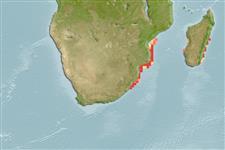Common names from other countries
Elasmobranquios (tiburones y rayas) (sharks and rays) >
Carcharhiniformes (Ground sharks) >
Pentanchidae (Deepwater catsharks)
Etymology: Halaelurus: halos (Gr.), sea; ailouros (Gr.), cat, probably an allusion to the vernacular “catshark,” so named for its cat-like eyes. (See ETYFish); lineatus: Latin for lined, referring to its 13 pairs of narrow dark-brown stripes. (See ETYFish).
Environment: milieu / climate zone / depth range / distribution range
Ecología
marino demersal; rango de profundidad 0 - 290 m (Ref. 5510). Subtropical; 19°S - 31°S
Western Indian Ocean: Beira, Mozambique to East London, South Africa.
Tamaño / Peso / Age
Maturity: Lm ? range ? - ? cm
Max length : 56.0 cm TL macho / no sexado; (Ref. 244); 52.0 cm TL (female)
Short description
Claves de identificación | Morfología | Morfometría
Espinas dorsales (total) : 0; Espinas anales: 0. A catshark with an upturned knob on the snout, a narrow head, and numerous small dark spots on the body (Ref. 5578). Pale brown with numerous pairs of narrow, vertical, dark brown stripes outlining obscure dusky saddles (Ref. 5578), cream below (Ref. 5510).
Found on the continental shelf and uppermost slope, on soft bottoms, from close inshore to 290 m (Ref. 5578). Feeds on small crustaceans, bony fish, and cephalopods (Ref. 5578). Although commonly caught by shore anglers, it is not generally considered a game fish (Ref. 12484).
Life cycle and mating behavior
Maturities | Reproducción | Spawnings | Egg(s) | Fecundities | Larva
Probably lays eggs, with up to 16 egg-cases per female; eggs retained until embryos reach advanced stage of development (Ref. 5578).
Compagno, L.J.V., 1984. FAO Species Catalogue. Vol. 4. Sharks of the world. An annotated and illustrated catalogue of shark species known to date. Part 2 - Carcharhiniformes. FAO Fish. Synop. 125(4/2):251-655. Rome: FAO. (Ref. 244)
IUCN Red List Status (Ref. 130435)
CITES (Ref. 128078)
Not Evaluated
Threat to humans
Harmless
Human uses
Pesquerías: sin interés; pesca deportiva: si; Acuario: Acuarios públicos
Herramientas
Special reports
Download XML
Fuentes de Internet
Estimates based on models
Preferred temperature (Ref.
115969): 18.6 - 25.3, mean 22.7 (based on 22 cells).
Phylogenetic diversity index (Ref.
82804): PD
50 = 0.5078 [Uniqueness, from 0.5 = low to 2.0 = high].
Bayesian length-weight: a=0.00269 (0.00144 - 0.00502), b=3.05 (2.88 - 3.22), in cm Total Length, based on LWR estimates for this species & (Sub)family-body (Ref.
93245).
Nivel trófico (Ref.
69278): 4.5 ±0.60 se; based on food items.
Resiliencia (Ref.
120179): Bajo, población duplicada en un tiempo mínimo de 4.5-14 años (Fec assumed to be <100).
Fishing Vulnerability (Ref.
59153): Moderate vulnerability (42 of 100).
